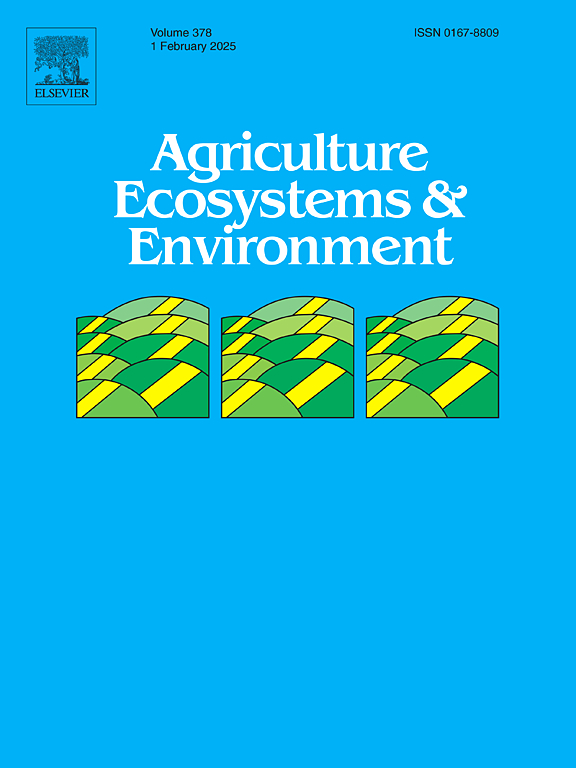Key functional guilds with high trophic level organisms in soil are vital contributors to greenhouse gas emissions from cropland
IF 6
1区 农林科学
Q1 AGRICULTURE, MULTIDISCIPLINARY
引用次数: 0
Abstract
Soil microbes drive nutrient cycle and strongly affect the fluxes of greenhouse gases (GHGs) globally. However, the mechanisms through which the key functional guilds regulate GHG fluxes from cropland remain unclear, especially those involving organisms at higher trophic levels of the soil micro-food webs. Therefore, the responses of key functional guilds to fertilization strategies and their contributions to the fluxes of dominant GHG were estimated to improve our mechanistic understanding. Typical fertilization regimes across the country were included in a long-term field experiment: regular synthetic fertilizers (NPK), partial synthetic nitrogen replacement with pig slurry (OMNPK) and crop straw (RSDNPK) plus a nil fertilizer control (Ctrl). The soil was a net sink of CH4, while fertilization treatments increased the fluxes of N2O and CO2. The cumulative N2O and CO2 emissions followed the order of RSDNPK > OMNPK ≈ NPK > Ctrl. Among the three GHGs, CO2 was the dominant one due to its high quantity and showed strong correlations with five soil labile and stable organic carbon and nitrogen fractions. The key functional guilds that strongly correlated with CO2 fluxes at the aggregate scale were composed of not only soil microbes, but also protists (14–19 %) and nematodes (3–4 %). Fertilization with organic amendments (OMNPK and RSDNPK) significantly changed the composition of the key functional guilds, which, along with key soil parameters, explained 26–35 % of the variation in CO2 fluxes. Protists were ranked as the 1st or 2nd most important biological group in determining the composition of the key functional guilds in all aggregate classes. Conclusively, soil biological groups at higher trophic levels, particularly protists, can serve as the important driver of GHG emissions. Manipulating their activities through targeted fertilization offers an alternative to mitigate the climate impacts of crop production.
土壤中具有高营养水平生物的关键功能行会是农田温室气体排放的重要贡献者
土壤微生物驱动养分循环,强烈影响全球温室气体的通量。然而,主要功能群落调节农田温室气体通量的机制仍不清楚,特别是那些涉及土壤微食物网较高营养水平的生物的机制。因此,我们估计了主要功能行会对施肥策略的响应及其对主导温室气体通量的贡献,以提高我们对机制的理解。在一项长期的田间试验中,采用了全国典型的施肥制度:常规合成肥料(NPK),用猪浆(OMNPK)和作物秸秆(RSDNPK)部分合成氮替代(OMNPK)加上无肥料控制(Ctrl)。土壤是CH4的净汇,而施肥处理增加了N2O和CO2的通量。N2O和CO2的累计排放量依次为RSDNPK >; OMNPK≈ NPK >; Ctrl。在3种温室气体中,CO2因其量大而占主导地位,并与5个土壤不稳定有机碳和氮组分表现出较强的相关性。在团聚尺度上,与CO2通量密切相关的关键功能行会不仅包括土壤微生物,还包括原生生物(14-19 %)和线虫(3-4 %)。施用有机肥(OMNPK和RSDNPK)显著改变了关键功能行会的组成,这与关键土壤参数一起解释了CO2通量变化的26 - 35% %。在所有职业中,原生生物在决定关键功能行会组成方面被列为第一或第二重要的生物群体。综上所述,高营养水平的土壤生物类群,特别是原生生物,可能是温室气体排放的重要驱动因素。通过有针对性的施肥来操纵它们的活动,为减轻作物生产对气候的影响提供了另一种选择。
本文章由计算机程序翻译,如有差异,请以英文原文为准。
求助全文
约1分钟内获得全文
求助全文
来源期刊

Agriculture, Ecosystems & Environment
环境科学-环境科学
CiteScore
11.70
自引率
9.10%
发文量
392
审稿时长
26 days
期刊介绍:
Agriculture, Ecosystems and Environment publishes scientific articles dealing with the interface between agroecosystems and the natural environment, specifically how agriculture influences the environment and how changes in that environment impact agroecosystems. Preference is given to papers from experimental and observational research at the field, system or landscape level, from studies that enhance our understanding of processes using data-based biophysical modelling, and papers that bridge scientific disciplines and integrate knowledge. All papers should be placed in an international or wide comparative context.
 求助内容:
求助内容: 应助结果提醒方式:
应助结果提醒方式:


